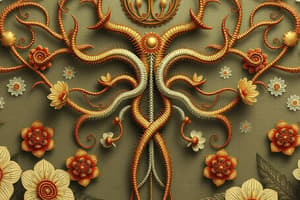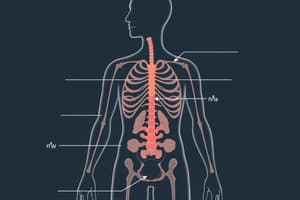Podcast
Questions and Answers
Which hormone is primarily responsible for stimulating the adrenal gland to release corticosteroids?
Which hormone is primarily responsible for stimulating the adrenal gland to release corticosteroids?
- Thyroid stimulating hormone (TSH)
- Growth hormone (GH)
- Adrenocorticotrophic hormone (ACTH) (correct)
- Luteinizing hormone (LH)
What is the main function of anti diuretic hormone (ADH)?
What is the main function of anti diuretic hormone (ADH)?
- Regulating metabolism
- Stimulating growth
- Stimulating uterine contractions
- Promoting water retention (correct)
Which of the following hormones is released by the anterior pituitary gland?
Which of the following hormones is released by the anterior pituitary gland?
- Prolactin-inhibiting hormone
- Oxytocin
- Anti diuretic hormone (ADH)
- Growth hormone (GH) (correct)
What impact does growth hormone-inhibiting hormone have on growth hormone secretion?
What impact does growth hormone-inhibiting hormone have on growth hormone secretion?
Which hormone is involved in both ovulation and androgen secretion?
Which hormone is involved in both ovulation and androgen secretion?
Which type of feedback mechanism amplifies a signal rather than turning it off?
Which type of feedback mechanism amplifies a signal rather than turning it off?
What type of hormones are produced by neurons and released into the bloodstream?
What type of hormones are produced by neurons and released into the bloodstream?
Which of the following is NOT a method of hormone release?
Which of the following is NOT a method of hormone release?
What is the primary function of hormones in the endocrine system?
What is the primary function of hormones in the endocrine system?
Which of the following is an example of negative feedback in homeostasis?
Which of the following is an example of negative feedback in homeostasis?
Where are releasing hormones produced?
Where are releasing hormones produced?
What distinguishes neuroendocrine cells from other types of cells?
What distinguishes neuroendocrine cells from other types of cells?
Which system involves constant monitoring and adjustments to maintain internal balance?
Which system involves constant monitoring and adjustments to maintain internal balance?
What is the primary requirement for hormone receptor activation?
What is the primary requirement for hormone receptor activation?
Where are receptors for lipophilic hormones typically located?
Where are receptors for lipophilic hormones typically located?
Which type of hormones cannot be stored in vesicles within endocrine cells?
Which type of hormones cannot be stored in vesicles within endocrine cells?
Which of the following describes the function of hormone receptor complexes?
Which of the following describes the function of hormone receptor complexes?
Which of the following hormones is classified as an amino acid derivative?
Which of the following hormones is classified as an amino acid derivative?
How do hydrophilic hormones primarily act on target cells?
How do hydrophilic hormones primarily act on target cells?
Which functional role is NOT associated with hormones?
Which functional role is NOT associated with hormones?
What categorizes hormones as lipophilic?
What categorizes hormones as lipophilic?
What role does the hypothalamus play in the endocrine system?
What role does the hypothalamus play in the endocrine system?
What is the primary function of the hypophyseal portal system?
What is the primary function of the hypophyseal portal system?
Which of the following hormones is NOT produced by the anterior pituitary gland?
Which of the following hormones is NOT produced by the anterior pituitary gland?
What does the release of prolactin (PRL) primarily influence?
What does the release of prolactin (PRL) primarily influence?
What is the primary role of T3 in the body?
What is the primary role of T3 in the body?
Which hormone is produced by the posterior pituitary gland?
Which hormone is produced by the posterior pituitary gland?
Which hormone is produced in excess during acromegaly?
Which hormone is produced in excess during acromegaly?
Which feedback mechanism primarily regulates hormone release in the endocrine system?
Which feedback mechanism primarily regulates hormone release in the endocrine system?
What is the function of calcitonin in the body?
What is the function of calcitonin in the body?
What structure beneath the brain houses the pituitary gland?
What structure beneath the brain houses the pituitary gland?
Which of the following statements is true regarding T4?
Which of the following statements is true regarding T4?
The anterior pituitary is composed of how many distinctive endocrinocytes?
The anterior pituitary is composed of how many distinctive endocrinocytes?
What can result from a deficiency of thyroid hormones during fetal development?
What can result from a deficiency of thyroid hormones during fetal development?
What is the role of parafollicular (C) cells in the thyroid gland?
What is the role of parafollicular (C) cells in the thyroid gland?
In what condition is a goitre typically observed?
In what condition is a goitre typically observed?
How does T4 convert to T3 in the body?
How does T4 convert to T3 in the body?
What is the effect of Vitamin D activation on calcium levels in the body?
What is the effect of Vitamin D activation on calcium levels in the body?
What effect does calcitonin have on calcium levels compared to parathyroid hormone?
What effect does calcitonin have on calcium levels compared to parathyroid hormone?
What hormones are produced by the adrenal glands?
What hormones are produced by the adrenal glands?
What triggers the synthesis of aldosterone?
What triggers the synthesis of aldosterone?
Where does aldosterone primarily exert its effects in the body?
Where does aldosterone primarily exert its effects in the body?
What is the primary action of aldosterone in the kidneys?
What is the primary action of aldosterone in the kidneys?
In the activation process of aldosterone, what occurs first?
In the activation process of aldosterone, what occurs first?
What might occur if a thyroidectomy unwittingly removes part of the parathyroid glands?
What might occur if a thyroidectomy unwittingly removes part of the parathyroid glands?
Flashcards
What are hormone receptors, and how do they work?
What are hormone receptors, and how do they work?
Hormones interact with target cells by binding to specific receptors located on the cell surface, in the cytoplasm, or in the nucleus. These receptors are programmed to recognize and bind to specific hormones, triggering a chain of events.
How do target cells respond to hormones?
How do target cells respond to hormones?
The effect of a hormone on a target cell depends on the cell's programmed response to the hormone. Different cell types may respond differently to the same hormone.
How do hormones affect gene expression?
How do hormones affect gene expression?
Hormones trigger specific cellular responses by activating or repressing genes within the target cell. This process involves hormone-receptor complexes binding to DNA in the nucleus, acting as transcription factors.
What are Peptide hormones?
What are Peptide hormones?
Signup and view all the flashcards
What are amino acid derivative hormones?
What are amino acid derivative hormones?
Signup and view all the flashcards
What are steroid hormones?
What are steroid hormones?
Signup and view all the flashcards
What are lipophilic hormones?
What are lipophilic hormones?
Signup and view all the flashcards
What are hydrophilic hormones?
What are hydrophilic hormones?
Signup and view all the flashcards
What is the anterior pituitary gland's role?
What is the anterior pituitary gland's role?
Signup and view all the flashcards
What is the function of Thyroid Stimulating Hormone (TSH)?
What is the function of Thyroid Stimulating Hormone (TSH)?
Signup and view all the flashcards
What is the function of Adrenocorticotrophic hormone (ACTH)?
What is the function of Adrenocorticotrophic hormone (ACTH)?
Signup and view all the flashcards
What is the function of Luteinizing hormone (LH)?
What is the function of Luteinizing hormone (LH)?
Signup and view all the flashcards
What is the role of Gonadotropin-releasing hormone (GnRH)?
What is the role of Gonadotropin-releasing hormone (GnRH)?
Signup and view all the flashcards
Lipid soluble hormones
Lipid soluble hormones
Signup and view all the flashcards
Homeostasis
Homeostasis
Signup and view all the flashcards
Negative feedback
Negative feedback
Signup and view all the flashcards
Positive feedback
Positive feedback
Signup and view all the flashcards
Neurohormones
Neurohormones
Signup and view all the flashcards
Paracrine hormones
Paracrine hormones
Signup and view all the flashcards
Autocrine hormones
Autocrine hormones
Signup and view all the flashcards
Primary and secondary endocrine Organs
Primary and secondary endocrine Organs
Signup and view all the flashcards
Hypothalamus' role in pituitary function
Hypothalamus' role in pituitary function
Signup and view all the flashcards
What is the role of the pituitary gland?
What is the role of the pituitary gland?
Signup and view all the flashcards
What hormones are produced by the anterior pituitary?
What hormones are produced by the anterior pituitary?
Signup and view all the flashcards
What are the hormones released by the posterior pituitary?
What are the hormones released by the posterior pituitary?
Signup and view all the flashcards
What is the hypophyseal portal system?
What is the hypophyseal portal system?
Signup and view all the flashcards
How does the hypothalamus control anterior pituitary hormone release?
How does the hypothalamus control anterior pituitary hormone release?
Signup and view all the flashcards
How is hormone release controlled?
How is hormone release controlled?
Signup and view all the flashcards
How do Hormones work?
How do Hormones work?
Signup and view all the flashcards
Diabetes Insipidus
Diabetes Insipidus
Signup and view all the flashcards
Gigantism
Gigantism
Signup and view all the flashcards
Acromegaly
Acromegaly
Signup and view all the flashcards
Location of the Thyroid Gland
Location of the Thyroid Gland
Signup and view all the flashcards
Hormones Produced by the Thyroid
Hormones Produced by the Thyroid
Signup and view all the flashcards
T3 vs. T4 Potency
T3 vs. T4 Potency
Signup and view all the flashcards
Thyroid Hormone Production
Thyroid Hormone Production
Signup and view all the flashcards
Function of Calcitonin
Function of Calcitonin
Signup and view all the flashcards
What is aldosterone?
What is aldosterone?
Signup and view all the flashcards
Where does aldosterone act?
Where does aldosterone act?
Signup and view all the flashcards
What stimulates aldosterone release?
What stimulates aldosterone release?
Signup and view all the flashcards
How does aldosterone exert its effects?
How does aldosterone exert its effects?
Signup and view all the flashcards
What is the overall impact of aldosterone?
What is the overall impact of aldosterone?
Signup and view all the flashcards
What is parathyroid hormone (PTH) and where is it produced?
What is parathyroid hormone (PTH) and where is it produced?
Signup and view all the flashcards
How does PTH regulate calcium levels?
How does PTH regulate calcium levels?
Signup and view all the flashcards
How does PTH compare to calcitonin?
How does PTH compare to calcitonin?
Signup and view all the flashcards
Study Notes
The Endocrine System
- The endocrine system is a system of ductless glands that secrete hormones directly into the bloodstream.
- It includes organs and tissues that produce and release hormones.
- Hormones act as chemical messengers, controlling a vast array of physiological processes.
- Endocrine glands are ductless, comprised of endocrine cells.
- These glands do not have ducts that lead to the outside of the body.
- They secrete hormones directly into the bloodstream.
- Hormones can also act as paracrine or autocrine regulators, affecting nearby or the same cells directly, rather than traveling through the blood.
- Target cells are cells that contain specific receptors (binding sites) for a particular hormone, allowing the hormone to trigger specific effects.
- Hormone receptors can be found on the cell's surface, cytoplasm, or nucleus.
- Hormonal actions are dependent on the programmed response of the target cells.
- Hormones can affect: fetal development and differentiation; cell growth and cancer; metabolism; cardiovascular function; renal function; skeletal function; reproductive function; immune function; central nervous system function.
Hormone Classification
- Hormones are classified into three main categories:
- Peptide hormones: chains of amino acids, synthesized in ribosomes and stored in vesicles; water-soluble and cannot readily pass through cell membranes.
- Amino acid derivatives: derived from tyrosine or tryptophan; water-soluble and often controlled by other hormones in the pathway
- Steroid hormones: derived from cholesterol, lipid-soluble and bind to intracellular receptors.
- Lipophilic hormones (fat-soluble) include steroid and thyroid hormones, binding to intracellular receptors.
- Hydrophilic hormones (water-soluble) include peptide and most amino acid-derived hormones, binding to extracellular receptors.
Types of Hormones
- Peptide Hormones
- Composed of chains of amino acids
- Synthesized in ribosomes; stored in vesicles
- Not lipid-soluble; receptor located on the cell surface
- Amino Acid Derivatives
- Derived from tyrosine or tryptophan
- Often controlled by other hormones
- Mostly water-soluble (except thyroid hormones)
- Steroid Hormones
- Derived from cholesterol
- Lipid-soluble; receptors inside the target cell.
Control of Hormone Release & Homeostasis
- Homeostasis maintains internal balance and is regulated by constant adjustments in neural and endocrine control (fine regulation).
- Negative feedback mechanisms turn off a signal to maintain balance in response to changes in body systems.
- Positive feedback mechanisms amplify a signal in a cycle. Child birth is an example of positive feedback.
- Hormonal release is controlled by both positive and negative feedback.
- Humoral stimuli involve changing blood ion levels or nutrients.
- Neural stimuli involve stimulation by nerves.
- Hormonal stimuli involve stimulation by other hormones.
Hypothalamus–Pituitary Axis
- The hypothalamus and pituitary gland work together as the 'main regulators' of the endocrine system.
- The hypothalamus releases hormones that either trigger or inhibit the pituitary gland's release of hormones.
- For example, release of hormones to stimulate the synthesis and secretion of hormones at the anterior pituitary
- The hypothalamus is part of the brain, controls anterior pituitary activity, and secretes releasing and inhibiting hormones.
The Pituitary Gland
- The pituitary gland is pea-sized and sits in a bony hollow below the brain.
- Called the "master gland," it regulates other endocrine glands via tropic hormones (those that regulate other hormone functions).
- It is divided into the anterior and posterior pituitary.
- The anterior pituitary is a true endocrine gland.
- The posterior pituitary is connected to the hypothalamus and releases hormones produced by the hypothalamus itself.
The Anterior Pituitary
- The anterior pituitary contains six major types of endocrine cells.
- These cells produce and release hormones under the control of hypothalamic hormones. The Hypophyseal Portal System is a communication network connecting the hypothalamus and the anterior pituitary.
- Examples of anterior pituitary hormones are TSH, ACTH, FSH, LH, PRL, GH.
The Posterior Pituitary
- The posterior pituitary is an extension of the hypothalamus.
- It stores and releases oxytocin and ADH, which are hormones produced by the hypothalamus.
- Oxytocin is involved in uterine contractions and breast feeding, while ADH regulates water retention.
The Thyroid Gland
- Located in the anterior neck, on the trachea
- The thyroid consists of two lobes, connected by an isthmus.
- The thyroid produces T3 and T4 (from iodine molecules and tyrosine).
- Calcitonin regulates calcium and phosphorus metabolism.
Actions of T3 & T4 and Pathology
- T3 and T4 are essential for body metabolism (BMR).
- They increase energy consumption and oxygen.
- Crucial for fetal (physical and brain) development and skeletal growth.
- Imbalances, such as hyperthyroidism or hypothyroidism, involve various symptoms and imbalances.
The Parathyroid Glands
- Located on the posterior surface of the thyroid gland
- Contains two types of cells: chief (produce PTH or parathyroid hormone) and oxyphil (function unknown).
- The parathyroid hormone is essential for regulating calcium levels in the blood and plays a role in calcium homeostasis (opposite to calcitonin).
The Adrenal Glands
- Situated on top of the kidneys.
- Consist of two parts: the outer cortex, which produces a variety of steroid hormones, and the inner medulla, which releases catecholamines (stress hormones such as adrenaline).
- Mineralcorticoids regulate mineral balance.
- In the adrenal cortex, glucocorticoids regulate glucose metabolism.
Cortisol
- Part of a system crucial for dealing with stress (physical, psychological, or physiological)
- It keeps blood glucose high enough for brain activity and other body functions.
- Maintains blood pressure
- Influences immune responses and inflammatory responses.
- Cortisol imbalance can lead to Cushing's syndrome or Addison's disease.
Other important details
- Neurohormones are neurotransmitters released into the bloodstream to control other organs.
Studying That Suits You
Use AI to generate personalized quizzes and flashcards to suit your learning preferences.




